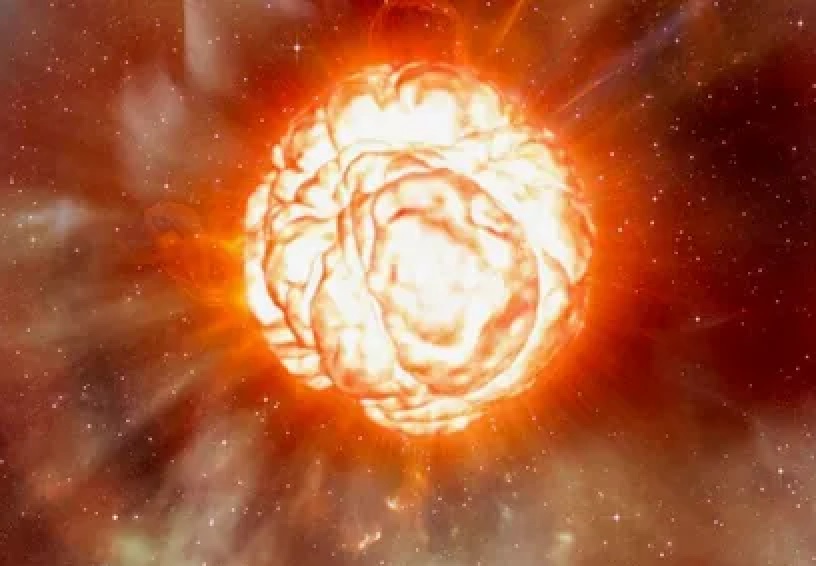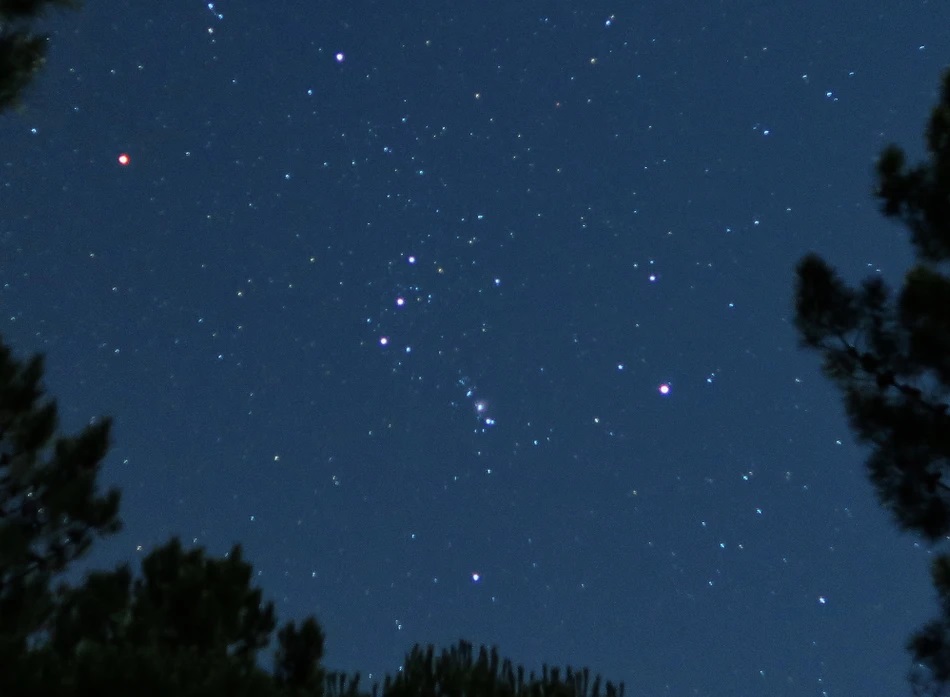Bodies belonging to the Solar System — planets, asteroids and comets — change their position relatively quickly against the background of distant stars. A few centuries ago, they were considered “immovable”. In the case of the Moon, this movement can be seen with the naked eye for several hours. Therefore, every year, on the same days, these bodies form different configurations. On the contrary, the conditions of visibility of objects in deep space depend only on the date, repeating every year. Which of them are best visible at the beginning of the calendar winter without the help of astronomical instruments? Let’s try to list seven of the most interesting ones.

Sirius
With the onset of darkness in December this year, Jupiter appears first in the sky, having passed the opposition a month ago. It shines with a bright, uniform yellowish light and remains above the horizon almost until morning. At about 9 p.m., a slightly fainter Sirius (α Canis Majoris) begins to rise above the southeastern part of the horizon, visibly flickering and even slightly changing color. All these “visual effects” are not its exclusive properties and are associated with the refraction of starlight in the Earth’s atmosphere. They appear only in the case of distant stars which disks cannot be seen in telescopes (even powerful ones). By the way, they can be distinguished from planets that do not flicker by this feature.

According to the accepted scale, the brightness of Sirius has a negative value and is equal to -1.47 magnitude. This means that the light flux from it is almost ten times greater than that from stars of the first magnitude. This star owes its high visible brilliance to the fact that it is located close to the Solar System in our era: now the distance to it is 8.6 light-years and will continue to decrease for about two thousand years. Only two galactic objects — the α Centauri system and Barnard’s star — are located closer to us.
Although Sirius belongs to the Southern Hemisphere of the Celestial Sphere, it is not so far from the celestial equator, so it can be seen in almost all inhabited areas of the Earth (except those lying north of 73° N). But it will not always be so. Due to precession and its own motion, the declination of the brightest star in the night sky gradually decreases, and around 8000, it will cease to rise above the horizon at the latitude of Kyiv.
Capra
The main star of the constellation Auriga is rarely remembered among the interesting objects in the sky. Although in fact it is the third brightest “fixed luminary” of the Northern Hemisphere of the celestial sphere and the only zero-magnitude star that can rise to the zenith for observers on the territory of Ukraine (near latitude 46). In the modern era, it has such a large declination that, in our latitudes, it does not hide behind the horizon at all and is observed all year round. In the first half of December, at midnight, it can be found directly overhead.
Capra is 43 light-years away from us. In fact, it consists of two yellow giants, one of which is 9 times larger than our Sun, and the second is 12 times larger. They orbit around a common center of mass at a distance of 110 million km with a period of 104 days. It has recently been proven that this pair has a moon — a system of two faint red dwarfs half the size and lighter than the Sun. Their orbital parameters are still being clarified.
Betelgeuse
The “miracle of the winter sky” can be called the entire constellation Orion — perhaps the most remarkable and clearly visible in both hemispheres of the Earth. But two of its “details” deserve special mention. And the first of them is Betelgeuse (α Orion). It is often cited as an example when the Greek letter “alpha” indicates not the brightest star of the constellation but the second brightest. But in this case, a “confusion” is appropriate to a certain extent since the brightness of Betelgeuse changes irregularly, and sometimes it becomes brighter than Rigel (β Orion). However, sometimes, on the contrary, it decreases significantly and for a long time. The most famous such case took place in late 2019 – early 2020.

Betelgeuse is a typical red giant, representing the final stage of the active existence of a hot massive star. It is 765 times larger than the Sun in size (according to some sources, more than a thousand times), that is, it is the largest object among the top ten brightest stars in the Earth’s sky. The distance to it is approximately 550 light years. Betelgeuse can be found not only due to its high brightness but also due to its expressive orange color. Scientists believe that in the next 10,000 years, this star will end its life with a powerful supernova explosion. In fact, it can happen even this winter…
Aldebaran and Hyades
When Orion just begins to rise above the horizon, another bright orange star already shines above it: Aldebaran (α Taurus). It is surrounded by a bunch of fainter stars, forming the brightest and closest scattered star cluster of the Earth’s sky to the Solar System — Hyades. Its main part occupies an area of about 20 square degrees in the sky, which is equivalent to a circle with a diameter of 5°. But this is only the core of the cluster: according to recent studies, it is generally an elongated “star stream”, all members of which move in the same direction and are about 625 million years old. On the celestial sphere, it extends from the constellation Orion to Perseus and Aries. The number of stars belonging to Hyades exceeds 400.

The “near edge” of the cluster is approximately 120–130 light-years away from us (its center is 153 light-years away). Aldebaran is much closer — the distance to it is 65 light-years. 300 thousand years ago, it was almost four times closer to the Sun and was the brightest star in the Earth’s sky. By the way, the name “Al-Dabaran” is translated from Arabic as “the follower”.
Pleiades
Not far from Aldebaran with the Hyades, it is difficult not to notice another decoration of the constellation Taurus — the scattered star cluster of the Pleiades. Each nation gave this pretty bunch of stars their names, Ukrainians know them as “Stozhary”.

In 1774, French astronomer Charles Messier presented the first version of his catalog of nebulous objects that prevented him from searching for comets since, when viewed through a small telescope, they often had a “comet-like” appearance. It included 45 star clusters, galaxies and gas nebulae (although at that time they were not distinguished by classes yet), and the last item in it was the Pleiades. It is not entirely clear why the scientist added them there; they do not look like any comet. But thanks to this, his brightest object appeared in the catalog. Later, it turned out that it was the closest one; the distance to the center of the cluster is now estimated at 444 light years. It consists of about 120 stars, but without a telescope, a person with normal vision sees only 11 of them in a clear, dark sky. The famous “bucket-shaped” figure is formed by 7 luminaries: Alcyone (the brightest), Atlas, Electra, Maia, Merope, Pleione, Taygeta. When looking at the sky, this figure seems very compact, but in fact it occupies an area of more than a square degree. The moon, passing against the background of the Pleiades from time to time, cannot completely obscure them.
Castor and Pollux
These two stars should be remembered together. Firstly, both of them are part of the same constellation, which has its name thanks to them: Gemini. Secondly, they are separated by only 4.5° in the sky. This is the only such “star pair” of objects brighter than the 2nd magnitude in the Northern Hemisphere of the celestial sphere. The other two form the constellation Crux, which has not been visible from the territory of Ukraine for almost three thousand years.
Although Pollux has the designation β Gemini, it is the brighter of this pair. This is an orange giant that is 34 light-years away. It is known that at least one planet similar to Jupiter orbits it. We are 52 light years away from Castor (alpha Gemini). In fact, it is a complex multiple system consisting of at least six components: four white giants and two red dwarfs.
Orion Nebula
One of the largest star formation regions in the galactic vicinity of the Sun is perhaps the faintest known object in the winter sky, still visible to the naked eye (in the absence of clouds and illumination). In the Messier catalog, it has the designation M42, but most often it is mentioned as the Orion Nebula.

In fact, this is the brightest similar area that observers at our latitudes can see. It surrounds the middle of the three stars of the Orion’s Sword, located under another famous asterism, the Orion’s Belt, lying halfway between Rigel and Betelgeuse. Visually, this star looks slightly larger than its neighbors, but even a small telescope will show that it is a system of several bright white luminaries shrouded in a cloud of interstellar gas. With powerful tools, you can distinguish a complex system of gas flows. The size of the nebula is quite difficult to estimate, according to recent estimates, it reaches 25 light-years. The distance to it is approximately 1,350 light-years.
Earlier, we wrote about what celestial phenomena associated with objects in the Solar System can be observed in December.
Follow us on Twitter to get the most interesting space news in time
https://twitter.com/ust_magazine


